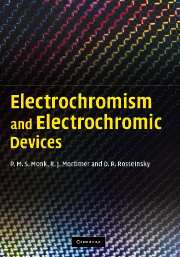Fundamentals of ECD construction
All electrochromic devices are electrochemical cells, so each contains a minimum of two electrodes separated by an ion-containing electrolyte. Since the colour and optical-intensity changes occurring within the electrochromic cell define its utility, the compositional changes within the ECD must be readily seen under workplace illumination. In practice, high visibility is usually achieved by fabricating the cell with one or more optically transparent electrodes (OTEs), as below.
Electrochromic operation of the ECD is effected via an external power supply, either by manipulation of current or potential. Applying a constant potential in ‘potentiostatic coloration’ is referred to in Chapter 3, while imposing a constant current is said to be ‘galvanostatic’. Galvanostatic coloration requires only two electrodes, but a true potentiostatic measurement requires three electrodes (Chapter 3), so an approximation to potentiostatic control, with two electrodes, is common.
The electrolyte between the electrodes is normally of high ionic conductivity (although see p. 386). In ECDs of types I and II, the electrolyte viscosity can be minimised to aid a rapid response. For example, a liquid electrolyte (that actually comprises the electrochromes) is employed in the world's best-selling ECD, the Gentex rear-view mirror described in Section 13.2. The electrolyte in a type-III cell is normally solid or at least viscoelastic, e.g. a semi-solid or polymer, as below.
In fact, virtually all the type-III cells in the literature are designed to remain solid during operation, as ‘all-solid-state devices’, or ‘ASSDs’.
